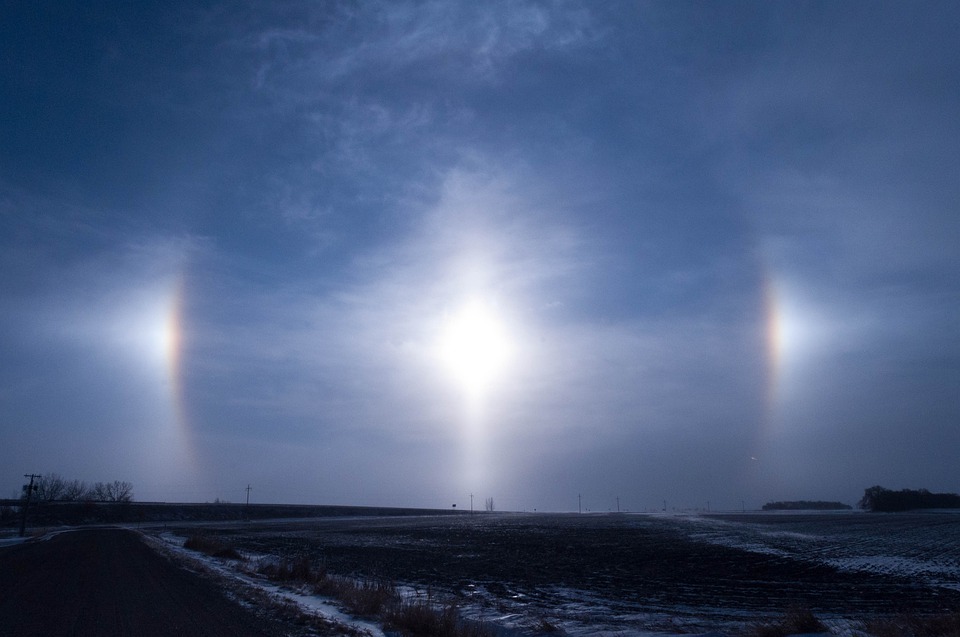A sun dog or sundog is an atmospheric optical phenomenon where bright patches of light appear on one or both sides of the Sun. In meteorology, it’s called a mock sun or a phantom sun, but its scientific name parhelion came from the Greek word parēlion meaning “beside the sun.” Most of the time, two sun dogs within a 22° halo borders the Sun. There are speculations that they are called as such because they seem to be following the sun just like dogs follow their masters.
The sun dog is among the family of halos which are caused by ice crystals’ refraction of sunlight in the atmosphere. Typically, sun dogs can be seen as a pair of colored areas of light that are at a distance of around 22° to the left and right sides of the Sun and are at the same distance above the horizon as the Sun. They are typically seen as a halo around the sun. Sun dogs can be observed anywhere in the world regardless of the season, but they are not always obvious or bright. Sun dogs are the most obvious and best seen when the Sun is near the horizon.
This optical phenomenon is often caused by hexagonal shaped ice crystals. It’s in these ice crystals (either suspended in cold cirrus or cirrostratus clouds, or drifting as diamond dust during very cold weather) where the refraction and scattering of light happens.These crystals act as prisms and bends the light rays that pass through them with a minimum deflection angle of 22°. Sunlight is refracted in a horizontal direction as the ice crystals, with their huge hexagonal faces nearly horizontal, gently float downward. Larger plates of ice crystals wobble more which is why they produce taller sundogs. It is then when sun dogs are observed on the left and right sides of the Sun.
Sun dogs are frequently displayed with reddish tints at the side that is nearest to the Sun. They sport tails that have a color grade of orange to blue that stretch horizontally away from the Sun. The tail is formed as light passes through the crystal at angles aside from the optimal deviation angle. The colors are muted and are never saturated. They also overlap a lot. If the parhelic circle is visible, the sun dog’s colors merge into the white of it.
Sun dogs, even when formed from ice crystals, can not only be observed during cold seasons. They can happen anytime and anywhere in a year. They are, however, most visible in the months of January, April, August and October when the sun is lower on the horizon. Oftentimes, when ice crystals in the atmosphere are more common, sun dogs occur but they can also be observed every time there are cirrus clouds.
The sundog can in fact shift away from the 22-degree point as the sun rises, but eventually, the sun rises to an even higher point and that’s when the sundog completely fades.
The ancient Greeks have realized that sundogs can be used as accurate weather forecasters. The ice crystals producing the halos and sundogs also form cirriform clouds. Cirriform clouds are usually the cloud formations that indicate a precipitating warm front.
The exact origin of the term sun dog still remains a mystery. The Oxford English Dictionary states the term as being “of obscure origin”.
In the 1882 Folk-etymology: A Dictionary of Verbal Corruptions Or Words Perverted in Form Or Meaning, by False Derivation Or Mistaken Analogy book by Abram Palmer, sun-dogs are described as:
A false sun’s phenomena which sometimes attend or dog the true when seen through the mist (parhelions).
Jonas Persson on the other hand, suggested that the term was derived from Norse mythology and archaic names. Sun dog is translated as solhunde in Danish and solhund in Norwegian, and in Swedish, it’s solvarg meaning sun wolf. In the Scandinavian languages, there are constellations showing two wolves hunting the Sun and the Moon, with one wolf after and one wolf before. It was theorized to be the possible origin for the term.
It was also thought to be of ancient Greek origins. The word Parhelion (plural parhelia) was derived from the Ancient Greek: παρήλιον (parēlion) which means ‘beside the sun’.
In Cornwall, United Kingdom, sun dogs are known as weather dogs in their Anglo-Cornish dialect. They are described as “a short segment of a rainbow seen on the horizon, foreshadowing foul weather”. Sun dogs or weather dogs are also known as lagas in the sky (lagas awel meaning ‘weather’s eye’)- a Cornish language term for the sun dog. This term is related to the Anglo-Cornish term cock’s eye which describes a halo around the moon or the sun which is also a sign of bad weather.
Sun dogs are also mentioned in literature, art and scientific papers. They were mentioned by famous Greek and Roman Authors like Aristotle and Aratus. Stephen King, also a famous author, wrote about it in his short story called “The Sun Dog”. In Shakespeare’s “King Henry VI, Part 3,” there was a dramatized appearance of sun dogs during the War of the Roses. There also exists a “Sundog Painting” (Vädersolstavlan) which depicts sundogs in Stockholm during 1535.


